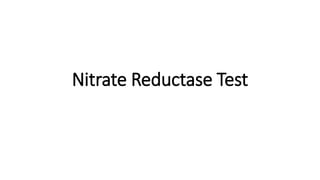
Nitrate reduction
- 6. Nitrate Reduction Test Significance •All members of the Enterobacteriaceae family reduce nitrate, but some members further metabolize nitrite to other compounds. It is thus used to differentiate members of Enterobacteriaceae that produce enzyme nitrate reductase from Gram negative bacteria that do not produce the enzyme nitrate reductase. •The reduction of nitrate may be coupled to anaerobic respiration in some species. •Identifying species of Neisseria and separating them from Moraxella and Kingella The nitrate reduction test is a critical test for differentiating between N. gonorrhoeae and K. denitrificans, particularly when strains of K. denitrificans appear to be gram-negative diplococci in stained smears. •Facilitating species identification of Corynebacterium
- 7. Principle The nitrate reduction test is based on the detection of nitrite and its ability to form a red compound when it reacts with sulfanilic acid to form a complex (nitrite-sulfanilic acid) which then reacts with a α-naphthylamine to give a red precipitate (prontosil), which is a water-soluble azo dye. However, only when nitrate is present in the medium, red color will be produced. If there’s no red color in the medium after you’ve added sulfanilic acid and α-naphthylamine means only that nitrite is not present in the medium. There is two explanations for this observation. 1.The nitrate may not have been reduced; the strain is nitrate-negative. 2.The nitrate may have been reduced to nitrite which has then been completely reduced to nitric oxide, nitrous oxide, or nitrogen which will not react with the reagents that react with nitrite; the strain is nitrate-positive. Thus, when nitrite is not detected, it is necessary to test if the organism has reduced nitrate beyond nitrite. This can be done indirectly by adding small amount of Zinc powder to the culture. Zinc powder catalyses the reduction of nitrate to nitrite. The development of the red colour on addition of Zinc indicates that nitrate was not reduced by the organism which suggests that the test organism is not capable of reducing nitrate. If no color change occurs after the addition of zinc, this indicates that the organism reduced nitrate to one of the other nitrogen compounds and thus is a nitrate reducer.
- 9. Diagrammatic representation of the detection of nitrite in medium.
- 10. Quality Control/Test Procedure QC strains: •Nitrate reductase-positive control: Kingella denitrificans, CDC 10,236 •Nitrate reductase-negative control: Neisseria gonorrhoeae, ATCC 43069 QC strains are stored at -70C in a solution of tryptic soy broth containing 20% glycerol. be confirmed at the time frozen stocks are prepared. QC strains may be stored at -70C for Media: Nitrate Broth Peptone 5 g/l, Meat extract 3 g/l, Potassium nitrate 1 g/l. Final pH 7.0 ± 0.2 at 25°C
- 11. Specimen Requirements Optimum specimen: A pure culture of a suspect gram negative, oxidase-positive diplococcus (Neisseria spp. or M. catarrhalis) on chocolate agar incubated in a carbon dioxide-enriched to 24 h. Unacceptable specimen: Cultures of isolates on chocolate agar incubated in a carbon dioxide- enriched atmosphere at 35C to 36.5C for more than 24 h. Compromising factors affecting test results: •Test medium must be inoculated heavily enough to permit reaction to occur with preformed may not permit organisms to use up oxygen to produce anaerobic conditions in which nitrate •Too much zinc dust added to the incubated tube may result in very rapid reduction of nitrate gases so that nitrite is not detected.
- 12. Method Determination of nitrate reduction to nitrite is a two step process. First, the reduction of nitrate to nitrite is determined by the addition of Nitrate Reagents A and B, then if necessary, the reduction of nitrate beyond nitrite is determined by the addition of Nitrate Reagent C (zinc dust). 1.Inoculate the nitrate broths with bacterial suspension. 2.Incubate the tubes at the optimal temperature 30°C or 37°C for 24 hours. 3.After incubation look for N2 gas first before adding reagents. 4.Add 6-8 drops of nitrite reagent A and add the 6-8 drops of nitrite reagent B. 5.Observe for the reaction (color development) within a minute or less. 6.If no color develops add zinc powder. 7.Observe for at least 3 minutes for a red color to develop after addition of zinc. Expected Results •Positive Test: – Development of a cherry red colouration on addition of reagent A and B – Absence of a red color development on adding Zn powder •Negative Test: – A development of red color on addition of Zn powder